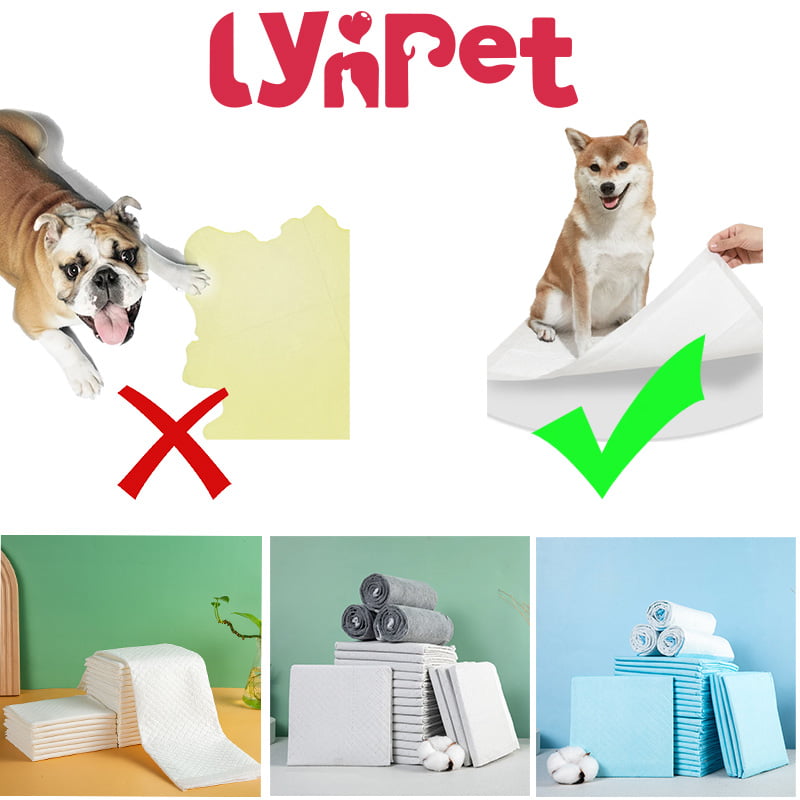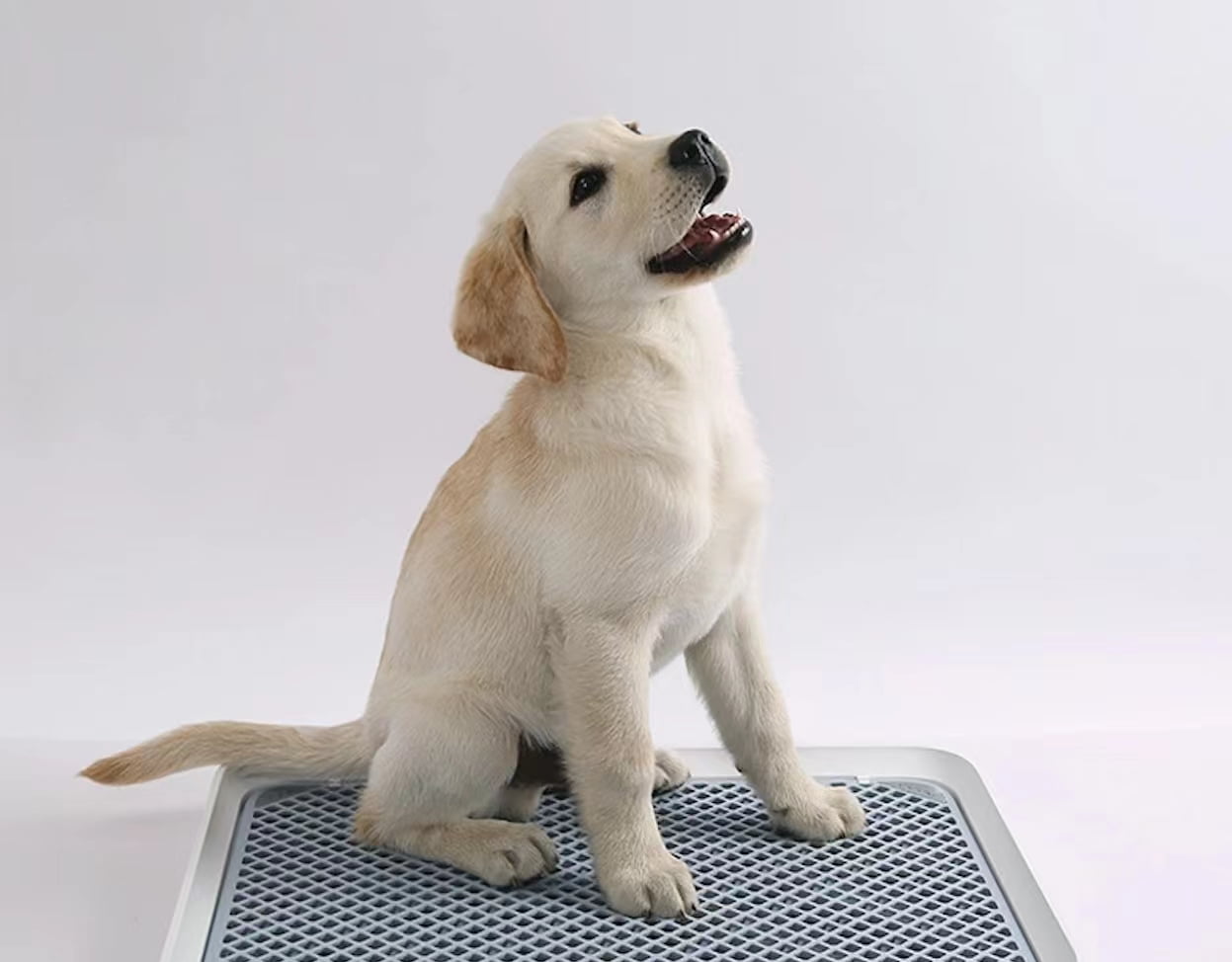If your dog previously used the pee pad but has suddenly stopped, it can be perplexing and concerning for pet owners. However, several factors could contribute to this change in behavior. Here’s a look at some potential reasons why won’t your dog pee on the pad anymore:
1. Owner’s Inconsistent Training Methods:
Trapped in Learning: The Confinement Dilemma:
- Some owners may rely on confinement methods, such as keeping the dog in a crate, to encourage the use of the pee pad. However, confinement alone does not necessarily teach the dog to use the pad. Instead, the dog may learn to hold its bladder while confined and then relieve itself elsewhere when given the opportunity. The owner might mistakenly believe that the dog has learned to use the pee pad due to periods of apparent cleanliness while confined. This misunderstanding can lead to frustration and confusion when the dog fails to use the pad once given more freedom.
Lack of Correction and Guidance:
- Some owners may only focus on rewarding their dogs when they use the pee pad correctly without providing any correction or guidance when accidents occur. For example, the owner may praise the dog when it urinates on the pad but ignore accidents or clean them up without any interaction with the dog. In more extreme cases, the owner might resort to scolding or shouting at the dog without offering proper guidance on where to eliminate it. This approach fails to effectively teach the dog the desired behavior and can lead to confusion and anxiety. Without clear guidance and correction, the dog may struggle to understand where it should be eliminated, resulting in inconsistent use of the pee pad.
Neglecting Training After Initial Success:
- Some owners may become complacent after their puppy successfully learns to use the pee pad before reaching six months of age. However, it’s crucial to continue consistent training and supervision beyond this milestone. Puppies enter a developmental stage known as the “adolescent period” between six to ten months of age, characterized by increased independence and testing boundaries. During this time, they may challenge previously learned behaviors, including proper elimination habits. If the owner neglects training and supervision during this critical period, the puppy may revert to inappropriate urination habits. Owners need to remain actively involved in their dog’s training and provide consistent guidance and reinforcement throughout the adolescent period and beyond to maintain good bathroom habits. Remember, consistent training and positive reinforcement are key components of successful long-term behavior management in dogs.
Solution 1: Crate Training
- When you first bring your puppy home, it’s essential to crate-train them effectively. Ensure the crate is appropriately sized with no extra items inside. After letting your puppy out of the crate, take them to the designated bathroom area immediately. If they don’t eliminate, wait until after they’ve eaten and drunk water before returning them to the crate and trying again. This process helps them associate the pee pads with bathroom activities and reinforces the idea that it’s acceptable to eliminate them.
Solution 2: Guided Toilet Training
- Regularly guide your dog to the designated bathroom area to help them become familiar with its location and surroundings. Use treats to encourage them to go to the designated spot, associating the action with positive reinforcement. With consistent guidance, your dog will learn to recognize the direction and area of the bathroom. Eventually, they will understand that when prompted to “go potty,” they should seek out the pee pad.
Solution 3: Timely Correction
- Once your dog learns to use the pee pad for elimination, they understand that it’s the appropriate spot for both urination and defecation. However, they may not realize that other areas are off-limits. Therefore, when your dog urinates inappropriately elsewhere, it’s essential to correct them promptly and guide them back to the pee pad. Consistent correction and redirection reinforce the understanding that the pee pad is the designated area for elimination.
2. Health Issues:
Urinary Tract Infections (UTIs):
- UTIs can cause discomfort and pain while urinating, leading a dog to avoid using the pee pad. Symptoms of UTIs in dogs include frequent urination, straining to urinate, and blood in the urine.
Bladder Stones:
- Bladder stones can obstruct the urinary tract, making it painful for a dog to urinate. Dogs with bladder stones may avoid using the pee pad due to the discomfort associated with urination.
Incontinence:
- Some dogs may suffer from urinary incontinence, which is the inability to control urination. This condition can be caused by neurological issues, hormonal imbalances, or weakened bladder muscles, making it difficult for the dog to use the pee pad consistently.
Diabetes:
- Diabetes can lead to increased thirst and urination in dogs. If a dog is drinking and urinating excessively due to diabetes, they may have difficulty using the pee pad consistently.
Old Age:
- Elderly dogs may experience urinary incontinence or difficulty holding their bladder due to age-related issues such as muscle weakness or cognitive decline. These factors can contribute to a reluctance to use the pee pad.
Regular veterinary check-ups are essential for monitoring your dog’s overall health and detecting any potential health issues early on. Your veterinarian can provide valuable guidance on maintaining your dog’s health and addressing any concerns that may arise. Additionally, they can offer advice on proper nutrition, exercise, and preventive care measures to keep your dog happy and healthy for years to come.
3. Pee pads issue
- Issues with the pee pads can lead to dogs refusing to urinate on them. Problems such as poor absorbency, leakage, or unpleasant odors may make the pee pads unappealing to dogs. Dogs are sensitive to their environment, and if they encounter discomfort or inconvenience with the pee pads, they may avoid using them for urination. As a result, they may seek alternative spots to relieve themselves, leading to accidents in the home.
These challenges with traditional pee pads highlight the need for a reliable solution that addresses these issues and encourages consistent bathroom habits in dogs. Lynpet brings new solutions to you!

Absorbency Disposable Underpads:
- Experience superior protection and comfort with our Absorbency Disposable Underpads, which are crafted from high-quality materials including non-woven fabric, premium wood pulp, and a waterproof, breathable film. Our innovative design ensures softness against the skin while offering reliable leakproof protection. With exceptional absorption powered by a superabsorbent polymer core, our underpad effectively wicks away liquids for a long-lasting dryness and ultimate comfort. Plus, enjoy double-action odor control that neutralizes unpleasant smells, keeping you feeling fresh. The textured, diamond-embossed surface promotes rapid dispersion and absorption of liquids, minimizing pooling and ensuring maximum efficiency.
Bamboo Charcoal Dog Training Pad with Super Lock Water:
- This pee pad is crafted with high-quality materials, including hydrophilic non-woven fabric, bamboo charcoal absorbent paper, polymer absorbent core fluff pulp, virgin wood pulp paper, and a PE film. Featuring a sleek grey color, our underpad offers superior absorbency, locking in moisture for a dry surface and preventing spills with its leak-proof design. Natural odor control is achieved through the use of bamboo charcoal, effectively neutralizing unwanted smells. Plus, our underpad is eco-friendly, and made with sustainable materials for a guilt-free choice. Available in multiple sizes, you can choose the perfect fit for your dog’s needs.
Basic Dog and Puppy Pee Pads:
- This pee pad is crafted with a combination of non-woven fabric, tissue paper, high-molecular absorbent material, PE waterproof film, and wood pulp. Featuring a soothing blue color, our underpad boasts an extra-thick design for durability and leak-proof protection, ensuring long-lasting reliability. Versatile in use, it’s perfect for pet care, baby diapering, feminine hygiene, and elderly care, making it a convenient choice for various needs. Soft and gentle on your pet’s skin, it provides comfort while helping to reduce odor, ensuring a pleasant experience for both you and your furry friend.
4. Environmental Changes:
- Environmental factors can also play a significant role in a dog’s reluctance to use pee pads. Changes in the dog’s surroundings, such as moving to a new home, the introduction of unfamiliar pets, or disruptions to their routine, can cause stress or anxiety. Dogs may feel unsettled or insecure in unfamiliar environments, leading them to reject using pee pads as their designated bathroom area. Additionally, if the pee pads are placed in high-traffic areas, near food and water bowls, or in locations that are too exposed or cramped, dogs may be hesitant to use them.
Creating a calm and comfortable environment, providing reassurance and positive reinforcement, and carefully selecting the placement of pee pads can help mitigate these environmental factors and encourage dogs to use them for urination.
5. In Conclusion
- In conclusion, understanding the reasons why dogs may refuse to use pee pads is crucial for addressing the issue effectively. Whether it’s due to problems with the pads themselves, health issues, or environmental factors, finding a solution is essential for maintaining good bathroom habits in dogs.

